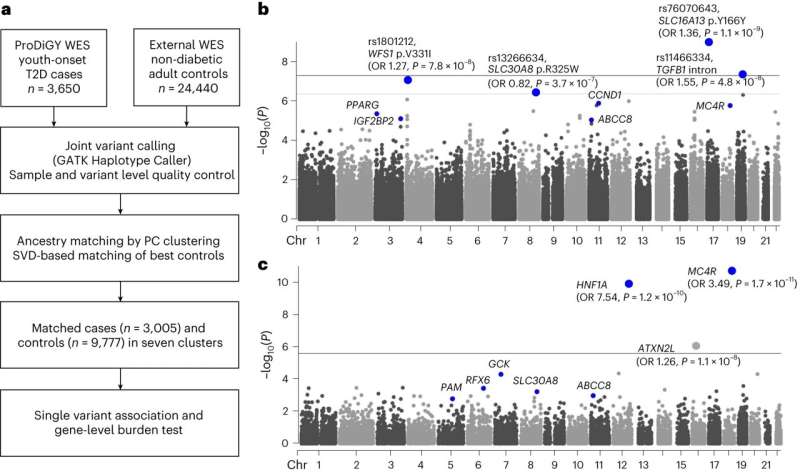This article has been reviewed according to Science X's editorial process and policies. Editors have highlighted the following attributes while ensuring the content's credibility:
fact-checked
trusted source
proofread
Study finds youth-onset diabetes is a genetically distinct form of the disorder

The diabetes field has long classified the disorder into genetically distinct groups, including type 1 and type 2. However, new genetics research focused on a form of type 2 diabetes (T2D) that is becoming more common in adolescents suggests a more complicated picture.
Researchers at the Broad Institute of MIT and Harvard, Boston Children's Hospital, and Harvard Medical School analyzed DNA from more than 3,000 T2D participants between 12 and 18 years old and nearly 9,800 adult controls, more than three-quarters of whom were of African American or Hispanic ancestry.
They found that youth-onset T2D is a genetically intermediate form of the disorder that lies on a spectrum between adult-onset T2D and rare forms of the disorder caused by a single gene. The study is published in Nature Metabolism.
Thousands of common genetic variants influence adult-onset T2D, whereas the rare genetic forms, known as monogenic diabetes, are caused by a single variant.
However, in a recent Nature Metabolism paper, the researchers showed that youth-onset T2D shared some of the same genetic features as both forms, carrying both common and rare genetic variants. Moreover, these individuals harbored more of these variants than people with adult-onset T2D, suggesting that genetics has a larger role in causing youth-onset T2D than in the adult-onset form.
The work also revealed that the specific mix of different types of variants a given individual carried correlated with their particular set of symptoms. For example, those with more common variants showed more symptoms of adult-onset T2D, such as high insulin levels.
The findings challenge current thinking about T2D by suggesting that there is more genetic overlap between the different forms of diabetes than previously thought.
"The way that clinicians subdivide diabetes patients now is based on symptoms, but in this study, the frequency of genetic risk factors seems to vary among patients with youth-onset T2D," said Jason Flannick, Broad associate member and assistant professor at Boston Children's Hospital and Harvard Medical School. "We didn't expect that frequency of genetic variants would correlate with clinical presentation, but that amazingly seems to be what we're seeing."
According to the study's first author, Soo Heon Kwak, a visiting scientist at Broad Institute in Flannick's lab and now a clinician based at Seoul National University Hospital in Korea, the study's findings challenge our current way of thinking about T2D and other complex diseases, which buckets patients into black-and-white symptomatic categories.
"Before this study, there was no clear view on the genetic architecture of youth-onset T2D. This provides a view of the overall genetics of diabetes," said Kwak.
Flagging risk factors
Disease-causing genetic variants are generally classified as common (appearing in more than 5 percent of the population), rare (less than 1 to 5 percent of the population), or monogenic (which are able to cause disease on their own). Teasing apart the contributions of these different types of variants in youth-onset T2D risk requires genetic data from thousands of patients.
To access such a large dataset, Kwak and Flannick turned to ProDiGY (Progress in Diabetes Genetics in Youth), a research consortium that has sequenced the exomes (the protein-coding region of the genome) of thousands of adolescents with T2D and also collected common genetic variant data from many thousands of healthy adults.
Their analyses demonstrated that the combination of common and rare genetic variants in youth-onset T2D have a greater influence on disease risk than in the adult-onset form. Youth-onset patients' common variant risk was three-fold higher, and their rare variant risk was five-fold higher.
Kwak and Flannick, building upon work previously published by the ProDiGY consortium, also found that 2.4 percent of the youth-onset T2D patients had monogenic diabetes, including a significant number of patients who carried variants in MC4R, a gene strongly linked to monogenic obesity. They said that these cases should be screened for monogenic diabetes, which might change the types of treatments they would receive.
"There's a nontrivial fraction that is worth getting screened for monogenic forms of diabetes, even if they don't exactly look like what typical monogenic cases look like," said Flannick.
Toward precision medicine
Researchers have long thought that common variants are the most significant genetic risk factor for diabetes, but Kwak says that the study may change that thinking. "There's been a long debate on the genetic architecture for T2D, and the field tends to lean toward the common variant hypothesis. But we show that there are rare variants that are important even after excluding the monogenic diabetes cases."
Kwak and Flannick hope that their study can inform the development of new diabetes treatments and add that their approach can be used to understand the genetic causes of other diseases better.
"I think this could have a huge impact on other studies of complex disease with early-onset forms," said Kwak. "There's a lot of heterogeneity in the different forms of common disease. With this model, we can understand other conditions' genetic architecture."
More information: Soo Heon Kwak et al, Genetic architecture and biology of youth-onset type 2 diabetes, Nature Metabolism (2024). DOI: 10.1038/s42255-023-00970-0



















